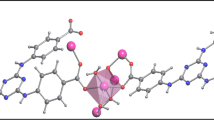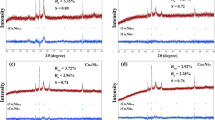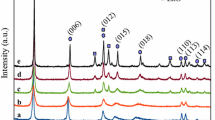Abstract
Metal-organic frameworks (MOFs) derived Co-based catalysts have received extensive attention in the chemoselective hydrogenation of nitroarenes, while they usually require a lot of solvent during the synthesis and identification of active species. This study explores a solid-phase synthesis strategy to obtain MOF precursors without using any solvent, which is then foamed and pyrolyzed to synthesize the Co@NC-X catalyst. It was found that a nitrogen-doped graphene shell can well encapsulate the Co nanoparticles. The resulting catalyst, which was pyrolyzed at 800°C, exhibited ~100% conversion for the hydrogenation of 3-nitrostyrene and >99% selectivity to 3-vinylaniline. This catalyst also showed excellent stability and good substrate universality for the hydrogenation of extensive substituted nitroarenes. Various characterizations revealed a positive relationship between the catalytic performance and the content of Co—N species tuned by pyrolysis temperature. This work provides a novel and green strategy to design an efficient Co-based catalyst for chemoselective hydrogenation.

摘要
金属有机骨架(MOFs)衍生的Co基催化剂用于芳香硝基化合物 选择加氢引起了广泛的关注, 但催化剂合成过程中使用大量溶剂, 且对 催化剂中活性中心的认识存在争议. 本文开发了一种固相合成策略, 在 不使用任何溶剂的情况下获得MOF前体材料, 经发泡和热解处理获得 Co@NC催化剂. 研究发现, 800°C热解所得的催化剂中Co纳米颗粒被 氮掺杂石墨烯壳层包裹, 在3-硝基苯乙烯的加氢过程中表现出~100% 的转化率, 3-乙烯基苯胺的选择性大于99%, 同时, 该催化剂具有良好 的循环稳定性和底物普适性. 表征和实验结果证明该催化剂中Co—N物 种为活性中心, 其含量可通过热解温度进行调变, 且催化性能与Co—N 物种的含量存在正相关关系. 本工作为设计用于选择加氢反应的高效 Co基催化剂提供了一种新的绿色合成策略.
Similar content being viewed by others
References
Han A, Zhang J, Sun W, et al. Isolating contiguous Pt atoms and forming Pt-Zn intermetallic nanoparticles to regulate selectivity in 4-nitrophenylacetylene hydrogenation. Nat Commun, 2019, 10: 3787
Huang L, Lv Y, Wu S, et al. Activated carbon supported bimetallic catalysts with combined catalytic effects for aromatic nitro compounds hydrogenation under mild conditions. Appl Catal A-Gen, 2019, 577: 76–85
Beswick O, Parastaev A, Yuranov I, et al. Highly dispersed cobalt oxides nanoparticles on activated carbon fibres as efficient structured catalysts for the transfer hydrogenation of m-nitrostyrene. Catal Today, 2017, 279: 29–35
Camacho-Bunquin J, Ferrandon M, Sohn H, et al. Chemoselective hydrogenation with supported organoplatinum(IV) catalyst on Zn(II)-modified silica. J Am Chem Soc, 2018, 140: 3940–3951
Formenti D, Ferretti F, Scharnagl FK, et al. Reduction of nitro compounds using 3d-non-noble metal catalysts. Chem Rev, 2019, 119: 2611–2680
Macino M, Barnes AJ, Althahban SM, et al. Tuning of catalytic sites in Pt/TiO2 catalysts for the chemoselective hydrogenation of 3-nitrostyrene. Nat Catal, 2019, 2: 873–881
Nandi D, Siwal S, Choudhary M, et al. Carbon nitride supported palladium nanoparticles: An active system for the reduction of aromatic nitro-compounds. Appl Catal A-Gen, 2016, 523: 31–38
Tamura M, Yuasa N, Nakagawa Y, et al. Selective hydrogenation of nitroarenes to aminoarenes using a MoOx-modified Ru/SiO2 catalyst under mild conditions. Chem Commun, 2017, 53: 3377–3380
Chen G, Xu C, Huang X, et al. Interfacial electronic effects control the reaction selectivity of platinum catalysts. Nat Mater, 2016, 15: 564–569
Chen LW, Tong L, Nan H, et al. Sub-2 nm Ir nanoclusters immobilized on mesoporous nitrogen-doped carbons as efficient catalysts for selective hydrogenation. ACS Appl Nano Mater, 2019, 2: 6546–6553
Fu H, Zhang L, Wang Y, et al. Thermally reduced gold nanocatalysts prepared by the carbonization of ordered mesoporous carbon as a heterogeneous catalyst for the selective reduction of aromatic nitro compounds. J Catal, 2016, 344: 313–324
Guo M, Li H, Ren Y, et al. Improving catalytic hydrogenation performance of Pd nanoparticles by electronic modulation using phosphine ligands. ACS Catal, 2018, 8: 6476–6485
Leng F, Gerber IC, Lecante P, et al. Controlled and chemoselective hydrogenation of nitrobenzene over Ru@C60 catalysts. ACS Catal, 2016, 6: 6018–6024
Lin L, Yao S, Gao R, et al. A highly CO-tolerant atomically dispersed Pt catalyst for chemoselective hydrogenation. Nat Nanotechnol, 2019, 14: 354–361
Mitsudome T, Kaneda K. Gold nanoparticle catalysts for selective hydrogenations. Green Chem, 2013, 15: 2636–2654
Tomkins P, Gebauer-Henke E, Leitner W, et al. Concurrent hydrogenation of aromatic and nitro groups over carbon-supported ruthenium catalysts. ACS Catal, 2014, 5: 203–209
Pan H, Peng Y, Lu X, et al. Well-constructed Ni@CN material derived from di-ligands Ni-MOF to catalyze mild hydrogenation of nitroarenes. Mol Catal, 2020, 485: 110838
Wei Z, Mao S, Sun F, et al. The synergic effects at the molecular level in CoS2 for selective hydrogenation of nitroarenes. Green Chem, 2018, 20: 671–679
Cui X, Liang K, Tian M, et al. Cobalt nanoparticles supported on N-doped mesoporous carbon as a highly efficient catalyst for the synthesis of aromatic amines. J Colloid Interface Sci, 2017, 501: 231–240
Fang H, Wen M, Chen H, et al. Graphene stabilized ultra-small CuNi nanocomposite with high activity and recyclability toward catalysing the reduction of aromatic nitro-compounds. Nanoscale, 2016, 8: 536–542
Jagadeesh RV, Stemmler T, Surkus AE, et al. Cobalt-based nanocatalysts for green oxidation and hydrogenation processes. Nat Protoc, 2015, 10: 916–926
Lu X, He J, Jing R, et al. Microwave-activated Ni/carbon catalysts for highly selective hydrogenation of nitrobenzene to cyclohexylamine. Sci Rep, 2017, 7: 2676
Ma Y, Lang Z, Du J, et al. A switchable-selectivity multiple-interface Ni-WC hybrid catalyst for efficient nitroarene reduction. J Catal, 2019, 377: 174–182
Ma Z, Liu H, Yue M. Magnetically recyclable Sm2Co17/Cu catalyst to chemoselectively reduce the 3-nitrostyrene into 3-vinylaniline under room temperature. Nano Res, 2019, 12: 3085–3088
Sorribes I, Liu L, Corma A. Nanolayered Co-Mo-S catalysts for the chemoselective hydrogenation of nitroarenes. ACS Catal, 2017, 7: 2698–2708
Westerhaus FA, Jagadeesh RV, Wienhöfer G, et al. Heterogenized cobalt oxide catalysts for nitroarene reduction by pyrolysis of molecularly defined complexes. Nat Chem, 2013, 5: 537–543
Goswami A, Kadam RG, Tuček J, et al. Fe(0)-embedded thermally reduced graphene oxide as efficient nanocatalyst for reduction of nitro compounds to amines. Chem Eng J, 2020, 382: 122469
Gao R, Guo H, Wang B, et al. Co based N, S co-doped carbon hybrids for catalytic hydrogenation: Role of cobalt salt and doped S. Appl Catal A-Gen, 2019, 579: 99–105
Lan X, Ali B, Wang Y, et al. Hollow and yolk-shell Co-N-C@SiO2 nanoreactors: Controllable synthesis with high selectivity and activity for nitroarene hydrogenation. ACS Appl Mater Interfaces, 2020, 12: 3624–3630
Sun X, Olivos-Suarez AI, Oar-Arteta L, et al. Metal-organic framework mediated cobalt/nitrogen-doped carbon hybrids as efficient and chemoselective catalysts for the hydrogenation of nitroarenes. ChemCatChem, 2017, 9: 1854–1862
Wang X, Li Y. Chemoselective hydrogenation of functionalized nitroarenes using MOF-derived co-based catalysts. J Mol Catal A-Chem, 2016, 420: 56–65
Chen FF, Chen J, Feng YN, et al. Controlling metallic Co0 in ZIF-67-derived N-C/Co composite catalysts for efficient photocatalytic CO2 reduction. Sci China Mater, 2022, 65: 413–421
Zhang J, Chen Y, Liu Y, et al. Self-catalyzed growth of Zn/Co-N-C carbon nanotubes derived from metal-organic frameworks as efficient oxygen reduction catalysts for Zn-air battery. Sci China Mater, 2022, 65: 653–662
Qi Z, Pei Y, Goh TW, et al. Conversion of confined metal@ZIF-8 structures to intermetallic nanoparticles supported on nitrogen-doped carbon for electrocatalysis. Nano Res, 2018, 11: 3469–3479
Wang X, Chen W, Zhang L, et al. Uncoordinated amine groups of metal-organic frameworks to anchor single Ru sites as chemoselective catalysts toward the hydrogenation of quinoline. J Am Chem Soc, 2017, 139: 9419–9422
Li M, Chen S, Jiang Q, et al. Origin of the activity of Co-N-C catalysts for chemoselective hydrogenation of nitroarenes. ACS Catal, 2021, 11: 3026–3039
Peera SG, Balamurugan J, Kim NH, et al. Sustainable synthesis of Co@NC core shell nanostructures from metal organic frameworks via mechanochemical coordination self-assembly: An efficient electrocatalyst for oxygen reduction reaction. Small, 2018, 14: 1800441
Chen S, Ling LL, Jiang SF, et al. Selective hydrogenation of nitroarenes under mild conditions by the optimization of active sites in a well defined Co@NC catalyst. Green Chem, 2020, 22: 5730–5741
Wei H, Liu X, Wang A, et al. FeOx-supported platinum single-atom and pseudo-single-atom catalysts for chemoselective hydrogenation of functionalized nitroarenes. Nat Commun, 2014, 5: 5634
Bergeret G, Gallezot P. Particle size and dispersion measurements. Handbook of Heretogeneous Catalysis, 2008, 2: 738–765
Liu L, Concepción P, Corma A. Non-noble metal catalysts for hydrogenation: A facile method for preparing Co nanoparticles covered with thin layered carbon. J Catal, 2016, 340: 1–9
Schwob T, Kempe R. A reusable Co catalyst for the selective hydrogenation of functionalized nitroarenes and the direct synthesis of imines and benzimidazoles from nitroarenes and aldehydes. Angew Chem Int Ed, 2016, 55: 15175–15179
Liu L, Gao F, Concepción P, et al. A new strategy to transform mono and bimetallic non-noble metal nanoparticles into highly active and chemoselective hydrogenation catalysts. J Catal, 2017, 350: 218–225
Wei Z, Wang J, Mao S, et al. In situ-generated Co0-Co3O4/N-doped carbon nanotubes hybrids as efficient and chemoselective catalysts for hydrogenation of nitroarenes. ACS Catal, 2015, 5: 4783–4789
Sun T, Zhao S, Chen W, et al. Single-atomic cobalt sites embedded in hierarchically ordered porous nitrogen-doped carbon as a superior bifunctional electrocatalyst. Proc Natl Acad Sci USA, 2018, 115: 12692–12697
Yu P, Wang L, Sun F, et al. Co nanoislands rooted on Co-N-C nanosheets as efficient oxygen electrocatalyst for Zn-air batteries. Adv Mater, 2019, 31: 1901666
Zhou D, Zhang L, Liu X, et al. Tuning the coordination environment of single-atom catalyst M-N-C towards selective hydrogenation of functionalized nitroarenes. Nano Res, 2022, 15: 519–527
Zhang L, Wang A, Wang W, et al. Co-N-C catalyst for C—C coupling reactions: On the catalytic performance and active sites. ACS Catal, 2015, 5: 6563–6572
Li H, Cao C, Liu J, et al. Cobalt single atoms anchored on N-doped ultrathin carbon nanosheets for selective transfer hydrogenation of nitroarenes. Sci China Mater, 2019, 62: 1306–1314
Jagadeesh RV, Murugesan K, Alshammari AS, et al. MOF-derived cobalt nanoparticles catalyze a general synthesis of amines. Science, 2017, 358: 326–332
Yang S, Peng L, Oveisi E, et al. MOF-derived cobalt phosphide/carbon nanocubes for selective hydrogenation of nitroarenes to anilines. Chem Eur J, 2018, 24: 4234–4238
Chen T, Guo S, Yang J, et al. Nitrogen-doped carbon activated in situ by embedded nickel through the Mott-Schottky effect for the oxygen reduction reaction. ChemPhysChem, 2017, 18: 3454–3461
Deng D, Yu L, Chen X, et al. Iron encapsulated within pod-like carbon nanotubes for oxygen reduction reaction. Angew Chem Int Ed, 2013, 52: 371–375
Wang J, Wei Q, Ma Q, et al. Constructing Co@N-doped graphene shell catalyst via Mott-Schottky effect for selective hydrogenation of 5-hydroxylmethylfurfural. Appl Catal B-Environ, 2020, 263: 118339
Xue ZH, Han JT, Feng WJ, et al. Tuning the adsorption energy of methanol molecules along Ni-N-doped carbon phase boundaries by the Mott-Schottky effect for gas-phase methanol dehydrogenation. Angew Chem Int Ed, 2018, 57: 2697–2701
Fu T, Wang M, Cai W, et al. Acid-resistant catalysis without use of noble metals: Carbon nitride with underlying nickel. ACS Catal, 2014, 4: 2536–2543
Zhang L, Zhou M, Wang A, et al. Selective hydrogenation over supported metal catalysts: From nanoparticles to single atoms. Chem Rev, 2020, 120: 683–733
Wang L, Zhu C, Xu M, et al. Boosting activity and stability of metal single-atom catalysts via regulation of coordination number and local composition. J Am Chem Soc, 2021, 143: 18854–18858
Xiong W, Zhou S, Wang L, et al. ZIF-derived Co-based catalysts for efficient hydrogenation of aromatic compounds: The study of the Co—Nx active sites. Ind Eng Chem Res, 2020, 59: 22473–22484
Acknowledgements
This work was supported by the National Natural Science Foundation of China (21808193, 21878283, 22022814, and 22002118), China Postdoctoral Science Foundation (2020TQ0245), the Science and Technology Innovation Development Plan of Yantai (2021XDHZ069), the Youth Innovation Promotion Association CAS (Y2021057), Dalian Science Foundation for Distinguished Young Scholars (2021RJ10), and Taishan Scholars Program of Shandong province (tsqn202103051).
Author information
Authors and Affiliations
Contributions
Wei H, Song H and Ren Y participated in the design of this study, conducted the experiments, performed data analysis and drafted the manuscript. Yan X and Fang G conducted the experiments. Wang W, Ren W and Zhu M provided assistance for the data acquisition and analysis. Lin J proposed the idea, supervised the research and revised the manuscript. All authors read and approved the content of the manuscript.
Corresponding author
Additional information
Conflict of interest
The authors declare that they have no conflict of interest.
Supplementary information
Supporting data are available in the online version of the paper.
Haisheng Wei received his PhD degree from Dalian Institute of Chemical Physics (DICP), Chinese Academy of Sciences (CAS) under the supervision of Prof. Aiqin Wang and Prof. Tao Zhang in 2015. His research interests focus on the design, synthesis and characterization of highly dispersed supported metal catalysts for the synthesis of fine chemicals.
Huaxing Song is currently a master student at the College of Chemistry and Chemical Engineering, Yantai University. His research interest focuses on the development of MOFs-derived materials and their corresponding performances in selective hydrogenation reactions.
Yujing Ren is currently an associate professor at the School of Life Sciences, Northwestern Polytechnical University (NWPU). He received his PhD degree from DICP, CAS under the supervision of Prof. Dangsheng Su, Prof. Aiqin Wang and Prof. Tao Zhang in 2020, and then joined the NWPU. His research interests include single-atom catalysis, selective hydrogenation/hydrogenolysis reactions and nanozyme.
Jian Lin received his PhD degree from the DICP, CAS in 2011. He is now a professor at the DICP. His research interests include controlled syntheses and characterizations of highly dispersed metal catalysts, and their applications in heterogeneous oxidation and hydrogenation catalysis.
Supplementary information
40843_2022_2108_MOESM1_ESM.pdf
Solvent-free synthesis of Co@NC catalyst with Co—N species as active sites for chemoselective hydrogenation of nitro compounds
Rights and permissions
About this article
Cite this article
Wei, H., Song, H., Ren, Y. et al. Solvent-free synthesis of Co@NC catalyst with Co—N species as active sites for chemoselective hydrogenation of nitro compounds. Sci. China Mater. 66, 169–178 (2023). https://doi.org/10.1007/s40843-022-2108-4
Received:
Accepted:
Published:
Issue Date:
DOI: https://doi.org/10.1007/s40843-022-2108-4




